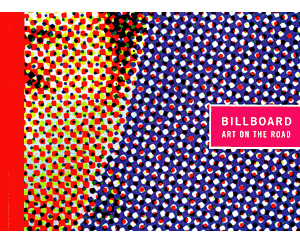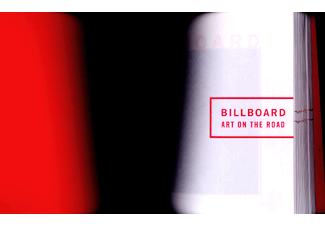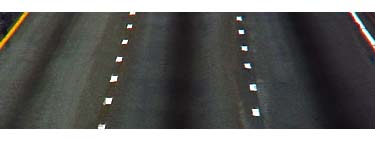What is an “artist’s billboard?” MASS MoCA’s Billboard: Art on the Road (MIT Press, 1999), while clearly documenting the museum’s 1999 retrospective of artist’s billboards, never fully defines the term. The essayists are vague about their definitions, casting the work as pop-art, commentary, subversion, and socio-political propaganda. Nowhere in the book do the essayists hazard that artist’s billboards (a neat trick of a phrase to avoid using “billboard art”) are, in the end, simply advertising. Billboards are overwhelmingly associated with our market-driven aesthetic and the art displayed in such places must either conform to it or be manipulated by it. Both factors, instead of elevating the artists’ billboards into the museum, bring the museum into the same low-brow context as Nike, Revlon, and Heineken. As Marshall McLuhan wrote: “The Medium is the Message.” The book has too many images to discuss here, so I will divide them into two manageable groups: 1) Billboards using only images, and 2) Billboards using text as their communicative element.

The most striking billboards in the book/exhibition are those without text. My favorite is Genévieve Cadieux’s Le Voie Lactéo (The Milky Way), Montreal, 1992. Cadieux, visually punning on her title as a place through which milk passes, uses the sensuous image of a pair of color-saturated, ruby-red lips—enlarged to billboard size: a striking image indeed. Cadieux’s billboard is free of text; as casual observers we are not even aware that it has a title. Free of these linguistic trappings, we are thus liberated to read into it what we may: sexuality, lust—the size of the piece could even convey feminine strength. Taken out of its outdoor/language-free context, photographed and hung on the wall of a gallery or printed in a book which labels and classifies the work as “art,” were are bound to interpret it as such. Art, classified, encourages us to look, think, digest, and interpret. This is what MASS MoCA’s retrospective encourages, an opportunity to think seriously about artists’ billboards. In the gallery, La Voie Lactéo can be read as art. The question that remains is: how was it originally apprehended and understood? Did it play on the street?
About half a year ago, I started to see word-free images on buses and billboards. These images were striking—a red star centered on a ground of green. What was this? No product that I knew about offhand had associations with this image. Was it a subversive communist message? Was it for Converse sneakers? I’m media-savvy; I’ve been trained through years of pop-culture manipulation to expect something like this. I’ve seen it before. This was an “installment-ad.” After a few months of this image piquing my curiosity, my patience would be rewarded by a follow-up. In this case it was Heineken. The red star was eventually incorporated into a greater ad, with a picture of the recognizable label, on which featured subtly is a red star that I had not noticed previously.
How then do the lips of Cadieux’s billboard differ from this imagery? It is art, but placed in an advertising context, what wins: art or advertising? La Voie Lactéo is bold; it piques my interest; it makes me ask, “What’s that all about?” But even in asking I expect my question to be answered in a few months with the equivalent of an ad man’s one-two punch. Jab! Look, here’s some sexy lips! Uppercut! You can have lips just like this if you buy Revlon!
Socio-political billboards have something they want to say. The message can be an overt bid. It can seek to motivate legislation or political awareness, as in Gran Fury’s Welcome to America, on which is pictured a black, diaper-wearing baby with the legend “Welcome to America, the only industrialized country besides South Africa without national health care.” Conversely, the message can be vague, as in Jenny Holzer’s (Outer Space) NYC, 1984. In this bus shelter billboard, the artist floats the following bold white text on a field of blue; the text is illuminated from behind:
Outer space is where
you discover wonder
where you fight and
never hurt earth. If
you stop believing this
your world turns ugly.
In contrast to Cadieux’s text-free image, these two billboards rely on language to make their point, and it is just that point which lies central to the piece. Both pieces are less than subtle in addressing their perceived societal ills. Fury’s America illustrates the need for public health care; Holzer’s surreal syntax calls for more value to be placed on outdoor spaces, coolly emphasizing a message of environmental conservation. Despite the fact that these billboards are promoting ideas rather than product, that their intent is for the general good rather than $$, they are still overtly selling something.

The last fifteen years or so has seen a phenomenon known as global branding. Corporations such as Benetton and Nike have closed their factories and contracted out the production aspects of their organizations to third-world laborers. Nike, it may surprise you, no longer makes shoes. Production is taken care of with very little out-of-pocket expense and Nike’s corporate goal, to which it devotes the lion’s share of its capital, is to create a corporate identity for its product—in effect “branding” the Nike swoosh into the mind of every consumer. The Nike corporation consequently becomes a megalithic advertising firm with one client, selling attitude rather than athletic shoes. Nike assumes that if we buy into the advertised attitude, it follows that we will buy the shoes.
Benetton is more subversive in their ad campaigns. Benetton ads align the corporation with ideas over attitude, eschewing the shallow vagaries of “cool” and attaching itself to something with supposed “depth.” Benetton’s ads have long promoted diversity, emphasizing its use of multi-racial models under the slogan “The Colors of Benetton.” The newest ad campaigns have Benetton identifying itself with the anti-death penalty movement, depicting full color faces of Death Row inmates, printing their names and dates of execution. The implication is that if we begin seeing these people as people, there is no possible way that we could kill them.
Advertising induces skepticism. As consumers, we have become more media-savvy. So ad agencies have devised ways around our perceived insight. For example, if Benetton endorses anti-death penalty laws, we see Benetton as a righteous crusader, a corporate ally with deep pockets and social concerns. In short: Benetton is a good company, a company that deserves our support. Benetton is an active player in this political struggle. Its ads supposedly promote awareness, rather than product. Why not buy its goods? The question I’d like to assert here is—Does Benetton really care about death row inmates or is this a roundabout way of manipulating me, tricking me into buying a product?”
This climate of global branding diffuses the social and political impact of Holzer’s and Fury’s work. While the artists’ messages seem to be unaligned with any corporate product or brand, we regard them with mistrust. Billboards are part of our landscape; part of the ubiquitous bid for our money. While these works make valid assertions, we mentally relegate them as attempt to manipulate our conscience towards the purchase of product. If we see a billboard that advocates free public health care, or one that encourages the building of more parks, it is hard to take it totally seriously. We see it, by association, as being marginally different than one selling Coca Cola. Perhaps we nod our agreement as we pass by in a speeding car, but by the time we hit the next billboard, selling Buick automobiles or Jack Daniel’s bourbon, its important message is forgotten.
The term “artist’s billboard” is an oxymoron. While not seeming to, the two words cancel each other out. As artists, critics, or simply art-fans we hope that artists are powerful enough to conquer their media, bending an unconventional form to their will. But a billboard’s semiotic associations are strong to the point of impenetrability; they are perceived as a ground whose sole domain is owned by advertising companies. If an artist takes over a billboard, his or her artwork is bent and skewed by our expectations. I do not expect to see “art” off of Route One. The MASS MoCA retrospective/book has a way of reframing these images, christening them as something new; they are not accurate reflections of what one might see on the road. The road diffuses the images; the gallery infuses them. The book/retrospective works as a history of artists’ billboards, but when it comes right down to it, the show/book belies the originals by giving the images more power than they would otherwise have.

